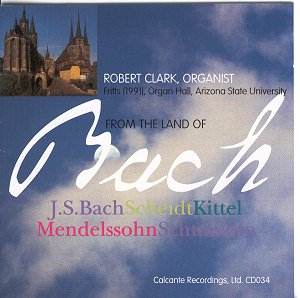 Composer: J. S. Bach (1685-1750), S. Scheidt (1587-1654), J. C. Kittel (1732-1809), R. Schumann (1810-1856), F. B. Mendelssohn (1809-1847)
Composer: J. S. Bach (1685-1750), S. Scheidt (1587-1654), J. C. Kittel (1732-1809), R. Schumann (1810-1856), F. B. Mendelssohn (1809-1847)
Works: Concerto in G Major after Johann Ernst BWV 592, Passamezzo SSWV 1071, Prelude in E-Flat Major, Prelude in E-Flat Minor, Prelude and Fugue in E Major BWV 566, Six Fugues on B-A-C-H, Op.60, Two Chorale Preludes: Valet will ich dir geben BWV 736, Herzlich tut mich verlagen BWV 727, Sonata no.3 in A Major
Performers: Robert Clark, Organ
Recording: Organ Hall, Arizona State University; Organ by Paul Fritts and Co., 1992; Recorded January 2000, Arizona State University, Temple, Arizona
Label: Calcante Recordings
Robert Clark’s recent release, From the Land of Bach, invites listeners into a richly textured soundscape that traverses the expansive timeline of Baroque to Romantic organ music. Featuring a selection of works by J. S. Bach, his contemporaries, and later admirers, this recording is both a homage to the great master and a testament to the enduring legacy of the organ repertoire. The chosen pieces, ranging from Scheidt’s lively Passamezzo to Mendelssohn’s sonorous Sonata No. 3, encapsulate the evolution of the organ’s voice across two centuries.
The recording is anchored by a Paul Fritts organ, whose mechanical action and voicing reflect the Baroque traditions of Arp Schnitger and the Hamburg school. The instrument’s warm acoustic envelops Clark’s interpretations, allowing the distinct colors of the organ to shine through. The registration choices throughout the program are historically informed; Clark navigates the constraints of the absence of a swell box with finesse, achieving smooth crescendi that breathe life into Schumann’s and Mendelssohn’s works. However, it is in Bach’s Prelude and Fugue in E Major BWV 566 where Clark’s interpretative prowess is most compelling, revealing the intricate counterpoint with clarity and vigor.
While the majority of the performances are commendable, there are moments when Clark’s technical execution falters. For instance, during Schumann’s Fugue No. 5, slight slips in fingerwork distract from the otherwise vigorous momentum. Similarly, in Scheidt’s Passamezzo, the trills in Variation 5 betray a lack of precision that diminishes the dance’s exuberance. Such instances, though regrettable, do not overshadow the overall musicality that Clark brings to the table. His sprightly rhythms and tidy fingerwork often outweigh these minor imperfections, particularly in the serene second movement of Mendelssohn’s Sonata, which blossoms with a calm, reflective quality.
The engineering of this recording merits attention, as the acoustic of the Organ Hall is rendered with clarity and distinction. The balance between the organ and the hall’s natural reverberation is well-maintained, allowing each note to resonate without overwhelming the listener. This careful attention to sound quality enhances the experience, enabling one to appreciate the subtleties of Clark’s playing and the instrument’s rich tonal palette.
The journey through this collection is both enlightening and engaging, although the occasional technical slip may leave discerning listeners wanting more. Clark’s interpretations, while occasionally marred by inconsistencies, provide an engaging exploration of a repertoire that bridges the gap between Bach and his 19th-century followers. The selection of works is thoughtfully curated, offering insight into the evolution of organ music in a historical context.
From the Land of Bach is a rewarding experience for those who appreciate the organ’s pivotal role in Western classical music. Despite its minor flaws, the recording stands as a valuable contribution to the organ discography, showcasing both the instrument’s capabilities and Clark’s interpretative skills. This album invites the listener to reflect on Bach’s indelible influence and the rich tapestry of music that emerged in his wake.



